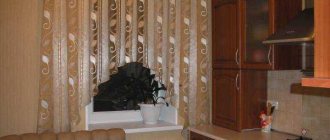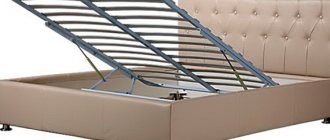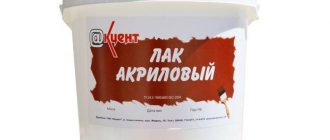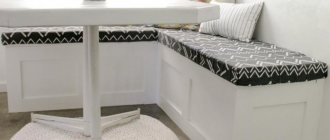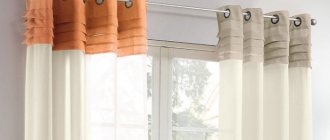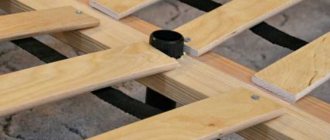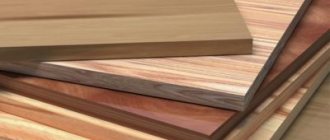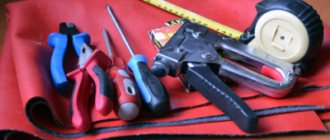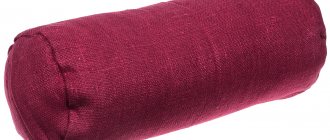Secrets of sewing a valance border
A number of rules must be taken into account. Many people have mastered their use, and you can cope with the task too.
Articles on the topic (click to view)
- Photo curtain for the kitchen
- Kitchen interior with black and white curtains
- Photos of beautiful curtains with eyelets
- Photo of voile curtains for the kitchen or living room
- Photo of a bedroom interior with beige curtains
- Tips on how to choose curtains for the bedroom: photos of interiors
- Curtains for an arch in the hall or kitchen
- You need to take measurements accurately. The bed is a fairly noticeable product. If you decorate it incorrectly, you will spoil the interior of the room. Exact measurements are taken for all components. If this is a classic - when the addition is created from several shreds - they are made even. If it is drapery, take into account the length of the border, etc.
- Select the right material. It depends on the chosen model, and it, in turn, is selected according to the model and decoration of the bed. You can find use for wool, light linen, and even tulle.
- Fastening principle. Often, practical designers make a temporary border. It can be attached and detached. The removable decor resembles a skirt, or you can choose a style for a bedspread, etc.
- Use quality materials and good fittings. It will be a shame if your hard work fails because you have not studied the raw materials well.
Why do you need a bed skirt?
Vintage pieces are all the rage these days, and beds are no exception. Antique headboards are fairly easy to find at an antique store or flea market. But the bed frame is more difficult to find. Any old one can be used here. But an old metal bed frame and a tattered box spring don't look very nice, which is where a bed skirt can come in handy.
Also, a skirt will help hide what should not be visible to strangers. For example, some housewives store jars with winter preparations, boxes with various things, stacks of magazines and other things under the bed that do not fit on the mezzanine. All these things can be perfectly hidden under a skirt.
This skirt is very easy to sew yourself. At the same time, it will not only be beautiful, but also comfortable, because it is attached with Velcro. In addition, sewing a product yourself is a guarantee that it will fit perfectly and the fabric will not be wasted. To save material, you can cheat a little: if the bed is in a corner, then the skirt can be made on only two sides, and if it’s just against the wall, then on three sides. When the skirt needs to be washed or simply removed, this is very easy to do with the help of Velcro. There are only advantages!
Rolled down the steps backstage: interesting excerpts from a new book about Magomayev
A designer friend told me the basic rules for choosing beautiful curtains for your home
The Voice of War and Victory: how did Levitan’s great-grandson grow up and did he follow in his footsteps?
Additional lifehacks
It is better to prepare the items and necessary components of the work in advance. So, it makes sense to prepare yourself for the fact that you will have to iron a lot. Irregularities often form in wrinkled fabric, which results in poor stitching.
The principle is based on the precise framing of the bed. Often such borders are called “skirts”, and designers understand what we are talking about.
It is not necessary to use an elastic band or garters. modern needlewomen choose Velcro.
The main thing is that when fastening the product, it does not harm the mattress or other items of linen sets. They do not need to be fastened together, they are combined temporarily, and then successfully unfastened.
Don't limit yourself in design. Let one bed have several “skirts”. They will require care, but it is not difficult. They are stored together with the laundry and taken out if necessary. They are easy to sew and use. But it is better to immediately make an optimally suitable design, rather than alter it many times.
Fantasy really has no limits here. A needlewoman can sew a unique frame, or crochet it, etc.
There are a lot of options. If you want something to decorate your bed, you will want something that is already on sale, ready-made textiles and decor.
There are now enough products to stop worrying about what you don't know how to do and get great products. They will decorate any room.
Expert opinion
Smirnova Ekaterina Anatolevna
7 years of experience in interior design, professional architect
Peculiarities
Let’s first understand what a “valance” is. This term refers to the decorative material used to frame the lower edge of the sleeping bed. And it's not just material. It can be made using fabric sewn with folds or gathers. When the bed is removed, the valance hangs down and covers the bottom of the bedroom furniture.
It is worth highlighting some positive aspects of using a valance on a sleeping bed:
- When purchasing a large bed, people often don’t think about the fact that they only have small bedding left from their old bed. For example, a bedspread that fit under old furniture will now be too small for a new bed. The valance solves this problem.
- The look of the bedroom changes along with the bed.
- A valance with pockets will allow your favorite things to always be nearby, and in the baby’s room it will serve to store necessary baby supplies, for example, diapers, bottles with formula or other important little things.
Models
When choosing, they are determined by the type of model. Common types:
- Strict. For sewing, smooth fabrics mixed with cotton or polyester are used. The model is characterized by counter folds that are stitched at the corners of the bed. A strict option is suitable for a classic style that takes a modern direction.
Strict valance for the bed - Draped. The model stands out with a large number of smooth folds. Light fabrics are used in the manufacturing process: silk, chiffon, tulle. Decorated with lace, ruffles, bows. The drapery looks gentle and aesthetically pleasing. Suitable for decorating a room in Provence or country style.
Drapery - Pleated. This option differs from the previous one by strictly highlighting the folds. For self-sewing, make clear drawings so as not to disturb the symmetry of the folds. To prevent folds from smoothing out, heavy fabrics are used for sewing: chenille, velvet, suede. Emphasizes the elegance of a room in a classic or vintage style.
Pleated valance
Models by design:
- as one with the coverlet. Covered over the bed. You can sew the product yourself: the valance is sewn to the bedspread.
One-piece option
- removable decor in the form of a skirt. The valance is attached to the bed or mattress frame using rope, elastic, loops, Velcro or tape.
Removable “skirt”
However, not every model is made from a material that matches the color palette of the interior. The right choice depends on taking into account important nuances. Otherwise, the valance will not last long or its texture will not fit into the design of the room.
The valance design should be compatible with the print of the bedspread and curtains in the room.
History of appearance
In ancient times, the sleeping bed was made much higher - this is understandable: the closer to the ceiling, the warmer the air. Thus, unoccupied space appeared under it for various household utensils.
Grandmothers, for example, constantly hid chests or unnecessary kitchen utensils there. Naturally, this approach is not aesthetically pleasing and they tried to cover it up with something, for example, a decorative curtain.
This is how the valance appeared, or in another way such a curtain is called a “skirt”.
It was also believed that the valance protected the family from evil spirits with the help of a pattern applied to it.
Therefore, this bedroom decoration was found in every home in ancient times. Over time, this approach began to become a thing of the past, as the height of the beds decreased, and the body began to look more modern and elegant.
However, the vintage past for women has not gone away; it has remained as a tradition, so it was not allowed to fade away completely. And now such decoration has become fashionable again.
Valance - a skirt for your bed
Everything new is well forgotten old. This saying perfectly suits the definition of this accessory. The valance, or as it is also called, the bed skirt, serves to hide the base of the bed, namely, the space under it. There are many types of valances. They can be made in the form of an extension of the bottom sheet (mattress cover), which is attached with an elastic band to the mattress itself, can be attached separately to the base of the bed using Velcro, and have different designs of folds and finishes. One constant rule is that the valance must match the color and texture of the fabric with the decoration of the bed.
The fact is that in a peasant hut, the higher you raise the bed, the warmer you will sleep - cold comes from the floor below. Naturally, such a large space - since the beds were very high, up to a meter high - was occupied with something: large chests, chests, baskets and whatever. And this valance, on the one hand, covered all these household items, that is, it worked in a household role as a kind of closet door, and on the other hand, it was always covered with incantatory embroidery or it was lace covered with incantatory ornament. Because the matrimonial bed is the place where children are conceived, procreation, and therefore it is necessary to protect the spouses, because among the people, the problem of giving birth from an evil spirit who has taken the form of a husband is a problem that is quite relevant, and therefore it is necessary to protect the matrimonial bed magically. Why were valances embroidered and not sheets? Because the sheet gets dirty and worn out, so the sheets were practically devoid of embroidery. But the valance, which gets dirty much less than any other household rag in the house, was perfect for storing such sacred information and at the same time protecting the reproduction of the family. (based on materials from www.culturhistory.ru)
2
3
4
If any of you want to sew a valance yourself, here you will find instructions5
6
7
8
11
flashdecor.livejournal.com
Models and colors
There are only a few varieties of such accessories for beds, which differ in style and design features. By style, valance can be divided into the following categories:
- Strict option. Suitable for classic and modern style bedrooms. The cut of the valance is such that the smooth fabric has counter folds both at the corners and in the middle of the material.
- Draped option. This style is very much loved by the female sex, due to its unpretentiousness and femininity. The fabric is filled with a mass of folds by gathering the fabric.
- Pleated type. Mainly used in classic style bedroom. The folds of this valance model are one-sided or counter pleated: they look smoothed and folded.
By design, the bed valance can be divided into the following variations:
- One-piece bedspread. It can be placed on top of the bed or placed under the mattress. Can be found on bed options where the drawers are relatively low. Otherwise, using a skirt valance design will be your best bet.
- Elasticated skirt. Instead, there can also be a ribbon, rope or some kind of sticky material. Installation occurs as follows: the skirt is put on the body of the bed (or on the mattress) only when the bed is tidied.
In most cases, valances are purchased for girls' bedrooms. Therefore, the most common shades of this paraphernalia are light and cream tones. They are able to make an airy sleeping bed out of massive furniture. And in case of highlighting furniture from other interior items, brighter shades are also suitable.
Review of yesterday and today
Often, grandmothers in villages, along with embroidered towels and tablecloths, also had decorative bed skirts - valances. What are they and why are they needed? As a child you don’t ask such questions.
Expert opinion
Smirnova Ekaterina Anatolevna
7 years of experience in interior design, professional architect
But later you find out that this is not just a beautiful piece of furniture, but a very practical and protective thing. However, like all other man-made things with which our not so distant but far-sighted ancestors surrounded themselves.
A valance is a frill used to decorate a sleeping area; it frames the bottom edge of the bed. One edge of the valance along the length was decorated with lace and embroidery and went down the front side of the bed almost to the floor.
Unlike modern models, our grandmothers’ beds were of a decent height and could reach a height of up to a meter. They were wooden or more often metal. Tall furniture was not used by chance, but to sleep as high as possible from the floor, where, with stove heating, the air was always much colder.
Thus, a spacious free space was created under the bed. And housewives preferred to use it for good - they placed a variety of chests, boxes, caskets, and baskets with household utensils there.
But it’s just not aesthetically pleasing. The valance served as a kind of screen hiding all these accessories from prying eyes.
That is, the purpose of this “skirt” was primarily functional.
However, the craftswomen, who used to be in every home, always decorated the valance with special ornaments or patterns in order to ward off all evil spirits and other people’s bad thoughts from the sleeping place. So a simple piece of fabric turned into a talisman, protecting a married couple from evil spirits.
The richness of the decoration depended on the skill and hard work of the housewife; they crocheted according to patterns, or the design was passed down from mother to daughter.
The motifs of embroidery on valances are varied: geometric and floral patterns, birds (ducks, roosters, peahens, etc.), animals (lion, leopard, horse), female figures, the motif of the world tree and images of mythological animals. In the territory of central Russia, especially in the Kostroma, Nizhny Novgorod, and Moscow provinces, on the valances you can see entire scenes depicting hunting, walking, etc.
Embroidery on valances was done in a variety of techniques (painting, cross, vestibule, pereviti flooring, Vologda glass, etc.).
In the northern provinces they usually embroidered with red or white threads on a white canvas. Most white valances, the first mention of which dates back to 1701, were made in the late 18th and early 19th centuries.
The color range of Central Russian and Southern Russian valances is much more diverse. Silk and gold thread are often used in the embroidery of Kostroma and Nizhny Novgorod valances. Lace valances, usually white, use geometric and stylized floral patterns and are usually finished with scallops.
Why were valances embroidered and not sheets? Because the sheet quickly becomes dirty, rubbed, and becomes unusable. But the valance, which gets dirty much less, was perfect for storing such sacred information, and at the same time protecting the reproduction of the family.
It is not known for certain when embroidered valances first appeared in Russian life. But after a short-term oblivion, they, having changed somewhat and lost their protective function, are returning to our interiors.
Modern valances
The saying – “everything new is a well-forgotten old” – finds its confirmation again and again.
So the “bed skirt” from the past is confidently entering the present as a fashionable decorative element. Only all the embroidered symbols have disappeared somewhere, and with them the ability to protect from evil spirits.
Apparently, modern master designers do not believe in what they do not see and do not know the symbolism of the patterns. But they know how to make it pleasing to the eye and fit into a particular style.
So, instead of openwork lace, when sewing, they often use heavy, expensive fabric that harmonizes with the overall style of the bedroom, repeating the color scheme of the curtains and bedspreads. Or for girls' bedrooms, valances are made from airy material, such as chiffon or tulle, in order to add charm and tenderness to the room.
There are many types of valances. They can be made in the form of an extension of the bottom sheet (mattress cover), which is attached with an elastic band to the mattress itself, can be attached separately to the base of the bed using Velcro, and have different designs of folds and finishes.
How to sew a bed valance?
Anyone who knows how to sew at least a little can easily cope with this task. For those who are not good at tailoring, a simple method that we found on the Internet is suitable.
You need to take old, unnecessary bedding. Cut it into strips with a large margin of length and width.
If the valance has folds, the length of each strip needs to be multiplied by 2 or 3. Let's say we have a bed 180 by 200 cm.
This means that the length of the frill will be 580 cm in total. If we make it draped or pleated, we will need stripes with a total length of 12 meters.
The parts are assembled directly on the bed and secured with pins. You can immediately gather the fabric or lay folds and secure them with needles.
Then you need to cut off the excess and, if necessary, make marks and sign the details. After this, the pattern elements are removed and measured.
“Finish” fabric is purchased according to size, and cutting is done. The parts are laid out again on the bed, the folds are secured with pins. Next, you need to make an estimate and sit down at the sewing machine.
If you don't have a machine, you can do without it. Using special adhesive tape and an iron, the edges of the fabric are processed. The parts are fixed directly to the base of the bed using double-sided tape, pins or something else. There is no need to wash the valance often, so this method is quite good.
If you sew several pockets to the valance, then books and favorite little things will always be at hand.
Spacious stripes on the crib valance allow you to store diapers, sanitary napkins and rattles.
But in order for every thing to have meaning, and not just decorativeness, it must be included there. So, if you decide to sew a valance for the bed in your bedroom, you apply Russian embroidery patterns to it - a simple piece of even bright fabric will immediately turn into magical and unique.
Create the world around you not just more beautiful, but also more consciously.
If you want to always learn about new publications on the site in a timely manner, then subscribe to our newsletter.
Creative design solutions
Follow these helpful design tips to transform your bedroom:
- books and favorite little things will always be at hand if you sew several pockets to the skirt;
- spacious stripes on the crib valance allow you to store diapers, sanitary napkins and rattles;
- light material will add tenderness to the bedroom, and bright colors will create accents;
- for a skirt, fabrics with stripes, polka dots, with unusual prints or floral patterns are suitable;
- you need to ensure that the sizes of the valance and the mattress match so that there is no uneven distribution of the fabric;
- for bed linen with a small pattern or flower, choose a valance made of plain material, and vice versa;
- Multi-layered skirts on round beds, made of contrasting material relative to the bedspread, look elegant.
When choosing a valance, you need to measure the distance from the top edge of the bed to the floor surface. Many manufacturers vary the size, although 15 inches is the standard. When the distance is 16 inches, the material will lie on the floor, if less than 14 inches, it will not completely cover the legs of the bed.
A skirt made of rigid fabrics gets dirty less often and does not need to be washed too often. If you use expensive fabric when sewing and smooth out the folds well, it will last for several years without losing its original appearance.
Creative proposals will transform the bedroom:
- oriental style - against the backdrop of a bed with a heavy canopy, a pleated brocade skirt, complemented by appliqué and embroidery, looks expressive. A combination of catchy fabric with golden tassels, oriental motifs along the edges is allowed;
- The Baroque style emphasizes draped skirts, made of expensive fabric with complex patterns of sheaves, garlands and laurel leaves. Fabrics suitable include silk or velvet of scarlet or emerald color;
- art deco - allows you to experiment with style and material. The bed valance can be sewn from soft pink, lilac or pink material, with eye-catching accents in the form of bright braid;
- eco-style - against the background of a wrought-iron bed, bedspreads and curtains with animal prints, a pleated chocolate-colored valance stands out, complemented by paintings depicting nature;
- country - the interior is characterized by bedspreads made of bright shreds, so you should choose a strict valance in honey or caramel color;
- mixed style - for those who love the comfort and warmth of the bedroom. Here, against the background of heavy curtains, a patchwork bedspread on a carved bed stands out, which is complemented by a stiff skirt in soft shades - mint or lemon.
For a northern bedroom, it is recommended to combine shades of beige and cream in the interior. Milky curtains with a golden bedspread look beautiful, and a traditional skirt in warm shades will create a comfortable atmosphere. In small bedrooms, shiny material is avoided for sewing bedding, which gives the room an official atmosphere.
Valances made from high-quality material, selected according to sizes that reflect the overall style of the bedroom, will last a long time. In addition to decorative value, ironed folds of fabric will reliably hide the legs of the bed and provide storage for unsightly boxes and drawers.
Why do you need a bed valance?
To create a romantic and at the same time cozy atmosphere in the bedroom, various textile elements are used: pillows, blankets and bedspreads. Also, the bed valance, so undeservedly forgotten and unused in our country, is coming back into fashion.
But, as you know, fashion returns, and with it, rare items and decorative elements become a fashion trend.
A little history
A valance is a frill used to decorate a sleeping area; it frames the bottom edge of the bed. In some countries it is also called a "skirt". This decorative element has been known since ancient times; our grandmothers and great-grandmothers used it to decorate their beds.
In those days, valance was used from a practical point of view. Unlike modern models, our grandmothers’ beds were of a decent height and could reach a height of up to half a meter. Such high furniture was not used by chance, but to sleep as high as possible from the floor, where the air was a little warmer.
The housewife put the resulting free space under the bed to good use by placing a variety of boxes, chests and caskets there. To hide all these accessories from prying eyes, they put on a valance, which served as a kind of screen.
Expert opinion
Smirnova Ekaterina Anatolevna
7 years of experience in interior design, professional architect
In addition to everything, he also acted as a talisman, protecting the married couple from evil spirits. Craftswomen decorated such a “skirt” with a special ornament or patterns that warded off evil spirits.
What role does a bed valance play?
From a historical point of view, such decor was sewn for a practical purpose. The design of the bedroom was not given much attention, but they tried to make the room as comfortable as possible. The valance was used as a kind of curtain (skirt) that hides caskets, chests or other things important to the owners.
Antique beds were made high. Sleeping at this level is comfortable, since the heat usually lasts for a long time in the upper part of the room. Therefore, the “skirt” was made of dense materials so that there was no draft during sleep.
Among other things, people believed that if you decorate your sleeping place with embroidery with protective symbols, then the person will not get sick.
The embroidery motif was varied. They embroidered amulets for newlyweds and for the cribs of small newborn children. Sometimes a geometric pattern of symbols or family history was applied. Features of this decor:
- multifunctional;
- practical;
- easy to sew the product yourself;
- long service life.
Modern use
Those times have long since sunk into oblivion; now this detail is used as a decorative element, adding charm and a romantic mood to the sleeping area. It is especially relevant for bedrooms that are designed in Country, Provence or classic style.
Although a strict valance can harmoniously fit into modern design, for example, minimalism, High-tech or Modern.
Very often, a “skirt” made of airy material, such as chiffon or tulle, is used to decorate a girl’s bedroom, adding charm and tenderness to the room.
If such an element has pockets, then it can serve not only a decorative function, but also perform a useful role, for example, there may be a book there that you usually read before bed.
Moms use valances with pockets in the children's room to store diapers, wipes and other small items.
Types of bed valances by style
When creating a bedroom design, the bed valance should match it. There are several styles of skirts: traditional, pleated and draped.
Traditional valance
A traditional bed skirt is suitable for a room designed in the styles of constructivism, art deco, kitsch and classic. The valance looks strict: it is a dense, heavy fabric with folds at the corners.
Pleated valance
A pleated sleeper skirt will perfectly complement styles such as classic and eco. When creating a pleated part, the folds are made at such a distance that they can be smoothed out later. The width and direction of the folds can be selected.
Drapery valances for beds
This design element adds romance and airiness to the room. A valance with drapery is suitable for a children's bed for a girl. For production, light chiffon or tulle is used, which is collected in small folds or flounces. Additional decorations include lace, bows and ruffles.
Models and colors
- Strict option. Suitable for classic and modern style bedrooms. The cut of the valance is such that the smooth fabric has counter folds both at the corners and in the middle of the material.
- Draped option. This style is very much loved by the female sex, due to its unpretentiousness and femininity. The fabric is filled with a mass of folds by gathering the fabric.
- Pleated type. Mainly used in classic style bedroom. The folds of this valance model are one-sided or counter pleated: they look smoothed and folded.
- One-piece bedspread. It can be placed on top of the bed or placed under the mattress. Can be found on bed options where the drawers are relatively low. Otherwise, using a skirt valance design will be your best bet.
- Elasticated skirt. Instead, there can also be a ribbon, rope or some kind of sticky material. Installation occurs as follows: the skirt is put on the body of the bed (or on the mattress) only when the bed is tidied.
Design options
There are two design options for these decorative elements:
- It looks like a single blanket , laid on top of bedding or placed on the base of the crib under the mattress.
- It is a “skirt” with elastic, rope, tape or Velcro. It is put on the mattress or on the bed frame itself after the bed is made.
The first design option is used if the side panels of the frame are not very high, and the base of such furniture is located almost at the same height as the top line of the frame. A cloth with a valance is spread on the base, and a mattress is placed on top.
If the side panels of the frame are large and the mattress is partially or entirely contained in the frame, a “skirt” is used. A one-piece bedspread with valance can be used for a variety of bed options.
Types of bed valances by structure
Bed skirts are divided by structure. They come in whole cloth, with elastic or Velcro. Let's consider below which option is best to use.
One-piece bed valance
A common option for decorating a bed. A one-piece bedspread with a valance for the bed is placed on its base and covered with a mattress on top. The design looks good on low beds.
One-piece bed valance
Bed valance with elastic and Velcro
The skirt with elastic is pulled over the top of the mattress or when you have already made the bed. Recommended for use on low beds. A Velcro valance is suitable for a sleeping place in which the mattress is recessed into the bed frame. It is simply glued to the base of the bed or to the bottom of the bedspread.
Bed valance with elastic.
How to sew a valance on a baby crib with your own hands
If you can do the bare minimum with a needle and thread, you can make a bed skirt. Prepare everything you need:
- pencil;
- centimeter;
- cotton fabric, tulle;
- threads, needles, scissors, pins;
- beads.
DIY valance
First measure the bed: length, width and height. Add to the resulting data 4 cm for length and 3 cm for width. This is necessary to take into account the fabric consumption for seam allowances and hems.
- Transfer the resulting parameters to the fabric by making a pattern.
- Cut out one main piece: this is a rectangle the size of a mattress and three strips of tulle
- Finish the edges of the fabric with a needle or sewing machine.
- Sew tulle and fabric using a sewing machine or using needles and threads;
DIY valance
- Start pulling the threads from the beginning of the workpiece, thereby forming folds.
- Sew the pleated strips to the main piece.
How to choose?
To ensure that the valance is ideal for your bed, you need to pay attention to several points:
- Size plays an important role when choosing a “skirt”. If it is large, it will not fit correctly on the bed, and, conversely, if it is very small, then you will not be able to put it on. In order to purchase this decorative element of the appropriate size, you need to measure the actual size of your bed; it may differ slightly from that indicated in the specification due to the mattress or springs. Pay attention to the height of the bed, taking into account the size of the mattress.
- The descent is the length from the top of the base of the bed to the floor. The standard size for ready-made valances is 38 centimeters, but they may differ among different manufacturers. If your length is 40 centimeters, then the “skirt” will not be able to fully reach the floor. If your length is 35 centimeters, then this decorative element will partially lie on the floor, disrupting the aesthetic appearance.
- Color design – bright colors can make an accent on the sleeping area. If you purchase a “skirt” of a light shade, for example, white, pink, cream, then you can make even the most massive furniture more airy and weightless.
- Pattern and print – a bed skirt is an excellent option to have an intricate design or pattern on it. These can be a variety of prints, geometric shapes or patterns. The valance can serve as a complement to textiles that are used to decorate the bedroom or play with contrast.
- Texture affects the service life of this decorative element. If it is made of dense material, then it will look like new for a long period of time. You will only have to remove it from time to time to wash it.
The most popular fabrics used to design a “skirt”:
You can decorate even the simplest valance yourself, using lace, applique elements, ribbons, inserts from other fabrics, this way you will make the “skirt” unique and extraordinary, adding zest and originality to it. Don't forget to iron this interior detail thoroughly, then the folds will hang beautifully.
A bed valance will allow you to create a complete image of your bedroom, adding comfort and harmony to it.
See below for more details.
(We decorate the bed with a valance)
Gathered valance
A bed with a gathered valance will add originality to the interior. Choose a fabric that matches the color of the bed linen, the size and length to suit your taste, and the room will become more comfortable.
The finishing edging placed between the middle panel and the frill emphasizes the clear, bright pattern of the long frill and gives the valance a finished look.
Soft drapery smoothes the contours of the furniture, lush folds cover the frame, bed legs and drawers under the bed. Let the color of the valance be in harmony with the pattern of other interior items - with the pattern of curtains or wallpaper.
Choose fabric to match your sheets, pillowcases and bedspread cover. It is best to sew a valance from light or not very heavy furniture fabrics.
Since only the frill will be visible when finished, the middle panel can be made from an old sheet or lining fabric. If you want to save even more, sew the frill to a wide strip of fabric that you tuck under the mattress.
How to sew a valance
Expert opinion
Smirnova Ekaterina Anatolevna
7 years of experience in interior design, professional architect
The valance is made to beautifully drape the foot and sides of the bed. If the middle panel is made from old or cheap fabric, it is better to hide it.
One way is to sew a border made of the same fabric from which the valance is made along the edges of the middle part before sewing the frill. To make a valance made of light fabric look lush, take a longer piece.
You will need: Fabric. Sewing threads.
Centimeter. Scissors.
Pins.
Curtains and valance made from the same fabric are a piquant feature of this bedroom. Vertical stripes on the valance give the bed a more grand look.
Open it up.
Cut the middle panel to the size of the bed, taking into account the measurements mentioned above. If necessary, increase the width of the panel. If the direction of the pattern does not matter, cut the ruffle strips the width of the fabric.
Preparing the middle panel.
Fold one of its short edges twice by 2.5 cm, pin and stitch.
Preparing the frill.
To get the frill to the desired length, sew strips of fabric with a French seam, matching the pattern along the seam. Fold the bottom and side edges of the frill twice by 2.5 cm and stitch.
Division into sections.
Measure the length of the frill and divide it into 6-8 equal sections, mark them with pins or bright basting threads. Measure the sides and open cut of the middle panel and divide them into the same number of segments. Mark the areas on the middle panel.
Gathering.
Place two lines at a distance of 1.2 and 2 cm from the open edge of the frill. To make it easier to pull out the thread, start and end your stitches at the reference marks.
Fitting the frill.
Fold the middle panel and frill right sides together, aligning the marks and open edges, and pin together. Gather the frill to the required length. Distribute the gathers along the panel, making them a little tighter at the corners for a better fit of the valance.
Stitching the frill.
Baste and stitch the frill, stitching between stitches to gather. Trim the frill seam allowance at the corners. Trim the seam allowances and finish the edges with tape or zigzag. Iron the frill allowances.
Advice.
Valance for a four-poster bed. If the base of the canopy frame is attached to the floor at the head and foot, sew a valance from separate pieces for the sides and foot of the bed so that the ruffles hang next to the corner pieces of the frame.
A valance of three stitched and gathered ruffles forms an ensemble with elements of a patchwork quilted bedspread and lushly draped curtains.
Economical valance
Fabric consumption can be reduced, which is especially important when sewing a valance for a very wide bed. Sew the frill not to the whole panel, but to a wide border and secure the border under the mattress.
Open up the frills.
Take your measurements and cut out the stripes for the frill. Cut strips along the weft of the fabric.
Open the edges.
Measure the sides and foot of the bed. Cut two 30cm wide strips 4.5cm longer than the side. Cut one 30cm wide strip 3cm longer than the footboard.
Cutting out corners.
Fold the ends of the footboard strip diagonally so that the cross sections coincide with the longitudinal edge. Cut along the fold. Cut off one corner of each side strip in the same way.
A simple short valance enhances the beauty of the bed with wrought iron headboards and at the same time covers its frame.
Stitching corners.
Place the strips right sides together, carefully aligning the bias cuts. Sew the corner seams with a 1.5 cm allowance.
Hem hem.
Fold the inner edge of the border twice by 1.5 cm. Open the ends of the corner seams and topstitch the hem. Fold the ends of the border twice by 1.5 cm and stitch.
Assembling the valance.
Prepare and sew the frill. Place the border under the mattress and straighten the valance.
Links on the topic,
How to make a canopy yourself?
A canopy over a cradle is not only beautiful. It is also protection from bright light, flies and mosquitoes. You don’t have to buy it at the store; you can sew it yourself. To do this you will need fabric, finishing tape, scissors, a needle and a sewing machine. You will also need a canopy holder, a hook and a cord. The holder can be made of strong wire or you can use a hoop.
The amount of fabric required depends on the height of the canopy and the mounting location - the ceiling or the back of the cradle.
The fabric chosen is natural, light, light colors.
For a crib canopy, natural chiffon, tulle or thin chintz are suitable. For ceiling mounting, you will need 4 m of material with a width of 1.5 m. Satin ribbon looks good as a finish. It will need 7 m.
The fabric is cut into two canvases measuring 1.5 m x 2 m. The canvases are folded together with the right sides inward and stitched along a length of 2 m, the seam is smoothed.
The result is a rectangle 3 m long and 2 m wide. The height of the crib canopy will be 2 m.
Scheme for cutting a canopy for a crib.
A 7 cm wide ribbon is folded in half lengthwise and smoothed. Baste it to 3 sides of the rectangle, starting from one of the sides, and stitch it. The fabric is in the middle of the tape. At the corners the tape is pinched, making turns. The remaining untreated upper edge of the canopy is folded over the entire length by 0.5 cm and smoothed with an iron. Fold it again by 3-4 cm, press it and stitch along the entire length.
Related article: Connecting an RJ-45 Internet socket and crimping the connector
Thick wire is bent into the shape of a circle with a diameter of 30-35 cm. You can use a hoop. The top hem of the crib canopy is placed on a wire, after which the ends of the wire are carefully secured. 3 cords 20-25 cm long are attached to the ring. They should be placed at the same distance from each other.
Above the crib, a hook is attached to the ceiling using dowels, from which the canopy will be hung by cords. The top of the canopy can be decorated with a bow from the same ribbon. In this case, more tape will be required. You can decorate a baby crib with bright appliques on the canopy, ruffles, frills, it all depends on the imagination of the needlewoman.
Return to contents

